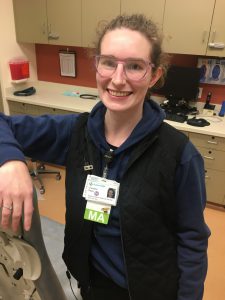By Meg Walker, Monique Binkley Smith and Liz Madison, Vitals contributors
Tina Reed could be referred to as a “first face of medicine.” As a medical assistant at Santa Rosa Same Day Care, she is one of the initial care team members who welcome patients into the busy care center.
“You may have a patient with a cough in one exam room, and a patient with a sore throat in a second exam room, and a patient with a hand laceration in a third exam room,” she said. “Most days it is very fast paced.”
Across the country, more people are returning for the care they may have postponed during the pandemic. To help meet this demand, healthcare systems are looking for creative ways to invite new medical assistant candidates to join their ranks.

Medical Assistant Tina Reed
Ambulatory care centers inside Northern California’s Sutter Health network open their doors to medical assistant—or MA—students through externships. These are training programs typically required for final certification from medical colleges. Students spend a month or six weeks at a care center, shadowing clinical professionals and gaining valuable hands-on training. They learn everything from taking vital signs, giving injections to reviewing insurance. Reed worked at Sutter Pacific Medical Foundation’s Santa Rosa Same Day Care as part of her externship through Santa Rosa Junior College.
“I was a little nervous, there are a lot of things to know,” recalls Reed. “But my trainers were excellent, and they taught me to take it one step at a time.”
Brandi Cleland oversaw the Sutter Medical Foundation MA externship in the North and Central Valley areas for nearly three years. It was a calling since she was also once an MA with her own personal story serving as inspiration.
Cleland was a stay-at-home mother of two who decided to get back into the workforce. She says she witnessed many MA applicants from all walks of life and with varying sources of motivation, which she believes is a great asset to the field—and especially to patients.
“These are people with real-life issues and a lot already on their plate,” she said. “But they also have the drive.”
In addition to providing students with work experience, hosting an extern is a way for managers to find good candidates, said Marc Talledo, medical and clinical student placement program supervisor for Sutter’s Department of Clinical Practice, Education & Development in the Bay Area.
“Externships are another interviewing tool, where managers can get a good feel for students and gauge whether they are a fit for the department,” Talledo said. “If they have an opportunity, they can bring them on as an employee.”
Sutter works with as many as 60 MA programs that host students as part of their academic experience. Sutter-affiliated care centers hosted more than 120 students in 2021. More Sutter affiliates, including Sutter East Bay Medical Foundation, plan on bringing externs on this spring—potentially growing that number.
According to Cleland, Sutter’s extern programs enjoy a good reputation among the schools, as well as the extern candidates themselves. She says the programs are also known among other employers as sources for candidates with extreme professionalism.
“We want the best of the best who are excelling in their classes and who want to build a career within Sutter,” said Cleland.

Justin Nguyen assists fellow Medical Assistant Brenda Padilla
Once externs complete their training and start working at a care center, they are supervised by a more experienced MA who has completed special training to be a preceptor and can coach new staff.
Medical assistant Brenda Padilla helps care for patients at Sutter Medical Foundation’s Downtown Internal Medicine office in Sacramento. Originally unfamiliar with medical assisting, she was a natural fit given her longtime caretaking of her grandparents and previous customer service experience. She instinctively segued into the role of preceptor. She says she appreciates how the role gives her the chance to learn from the students.
“I love seeing them flourish,” she said. “I’m not only teaching them, they are teaching me how to be a better trainer. We’re really teaching each other. That benefits our team and our patients.”





